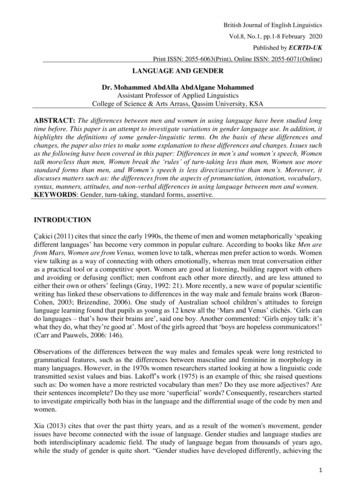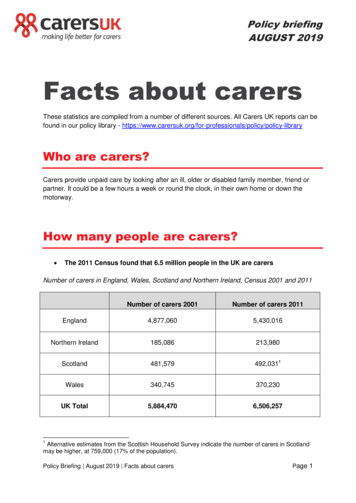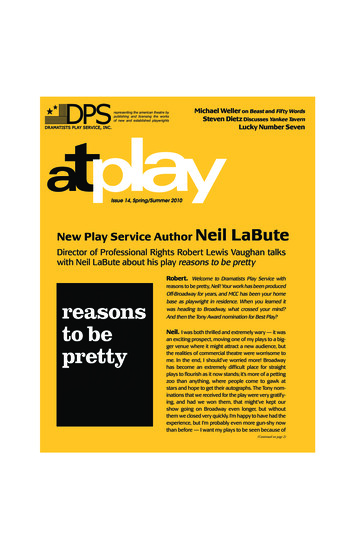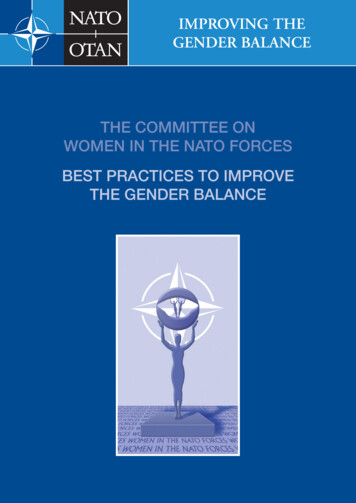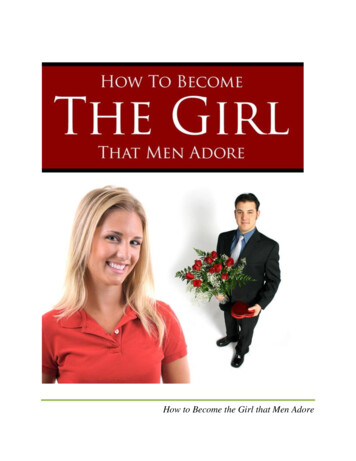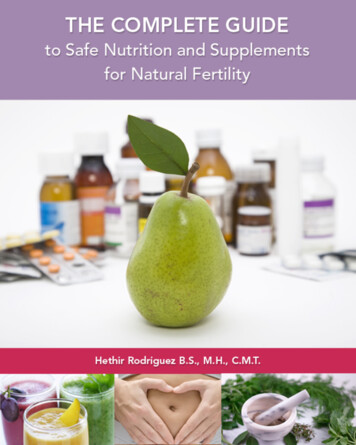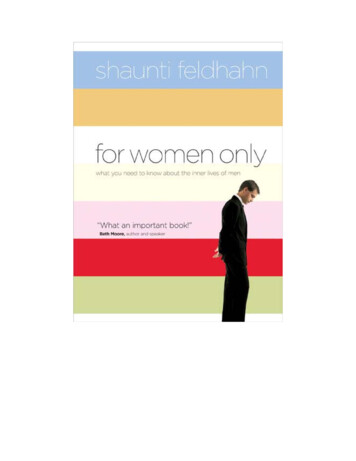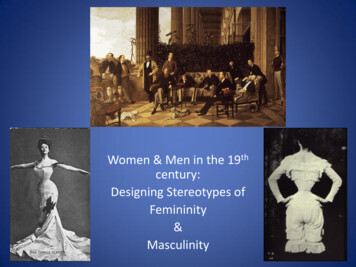
Transcription
Women & Men in the 19thcentury:Designing Stereotypes ofFemininity&Masculinity
19th Century Periods of Fashion The Empire Dress: 1790-1810 Romantic: 1815-1848 (Victoria ruled 1837-1901) Crinoline: 1840-1868 or Second Empire (rule ofNapoleon III, 1852-1870) Bustle: 1868-1890 Late Victorian: 1890’s three more silhouettes! Edwardian: 1901-1910 (Edward VII)Art Movements1780-1850: Romanticism1848-1900: Pre-Raphaelites, Arts and Crafts, Classicists1860-1900: Impressionists1880-1920: Art Nouveau
THE ROMANTIC PERIOD1815-1848 1794: Invention of the cotton gin, increased supply of cotton which made prices drop and production soar 1804-1815: Napoleon I Emperor of the French 1820’s: tailors beginning to make men’s clothing that was “ready made,” as well as custom-made clothing 1820s: machine -loom factories in Paisley opened to produce Indian cone patterned shawls rom Kashmir andwere named after the Scottish town where were crafted 1801: Joseph Marie Jacquard, a Frenchman, developed a type of mechanized loom for weaving patterned fabric.Based on the draw loom, this machine provided a means for raising and lowering yarns that formed patternsautomatically1811-1820: Regency Period in England1820s-1840s: mass production of lace on textile equipment. By 1840 most handmade lace patterns could be madeby machine in both narrow and wide widths, making lace trimmings and fabrics available at relatively low cost 1820: Prince Regent becomes King George IV of England 1830: publication of first American fashion magazine, Godey’s Lady’s Book 1835: dye chemistry improved which revolutionized textile printing. Patterned fabrics widely available 1837: Queen Victoria ascends the throne in England at the age of 18 1839: Louis Daguerre announces that he has found a method for making photographic images 1840: wedding of Queen Victoria to Prince Albert 1846: Isaac Singer makes and patents first successful sewing machine 1848-1849: Revolution in France; decline of Romanticism
Crinoline Period1840-1868 1850-1868: Queen Victoria continues to occupy the British throne 1850’s: Levi Strauss was selling blue jeans under the "Levi's" name in California 1852: Paris opens first department store housed in one building, Le Bon Marche 1855: Mass production of steel is patented 1856: aniline or synthetic dyes produced 1857: Hoopskirt or cage crinoline is introduced 1858: Charles Frederick Worth couture establishment in Paris1860: Charles Worth meets the Empress Eugenie and begins to design her clothes 1861: John Wanamaker’s opens in Philadelphia 1861-1865: Civil War in the United States 1863: Emancipation Proclamation ends slavery in the United States 1863: Ebeneezer Butterick patents the first sized, paper patterns for clothing 1867: Harper’s Bazaar, fashion magazine, begins publication
THE BUSTLE PERIOD AND THENINETIES 1870-1900: Queen Victoria continues to occupy the throne of England 1872: Steam-powered machine for cutting multiple layers of cloth introduced 1874: Impressionist artists show their work at the Salon des Independents in Paris 1892: Vogue magazine begins publication 1880’s and 1890’s: Aesthetic movement in the arts; English writer Oscar Wildelectures about Aestheticism in the United States 1890-1910: Art Nouveau style develops 1901: Queen Victoria’s death; Edward VII assumes the throne; first Paris exhibit byPablo Picasso
19th century silhouettesThe influence of national features in dress in Europe had been declining since about 1675and by 1800, fashionable dress design had become international. The character of thefeminine wardrobe stemmed from Paris, the masculine from London.
1680-1715 (Baroque) ; 1715-1774 (Rococo); 1775-1789 ; 1790-1799 (Directoire);1805(Empire); 1815-1848 (Romantic) ; 1840-1868 (Crinoline); 1868-1890 (Bustle) 1890’s;1900-1909 (Edwardian)
19th century MaleJames Tissot (French 1836-1902) , The Circle of the Rue RoyaleMen’s wear after 1800 was intended to demonstrate:The elimination of wasteful motionsA rational use of resourcesRejection of sensuality and individualityBehavior that was goal-directed and based on self-restraintAttire was to be: somber; austere; non-distracting
Exceptions to the Rule!The 1830s Dandy
Menswear: craftsmanship; impeccable fit; the essence of masculine sartorialproprietyTailoring; fit; restraint; elegance; qualityMorning and frock coats; morning suit; Norfolk jacket; plus fours; sack suits
A dramatic change in fashion history!A mantua at the Victoria and AlbertMuseum, dated to 1755-1760
1770s; 1795; 1795 Day dress, Round Gown; 1801;1830s; 1842; 1855 ;
1830
Roundabout Theater Company’s production of “The Importance ofBeing Earnest” at the American Airlines Theater
George “Beau”BrummelThe Original Dandy(1778-1840)1805
Pride and PrejudiceWritten by Jane Austin in 1813
The Arc of Characters
Using fine art to design charactersMrs Grace Dalrymple Elliot, c. 1778Thomas GainsboroughLady Catherine de Bourgh
18th Century Fashion Silhouettes
The Bennett’s!
Costumes and scenery working together
Queen Victoria by Thomas Sully, 1838Just before coronationQueen Victoria by Franz XaverWinterhalter, July 1842
Queen Victoria: lived 1819-1901; ruled 1837-1901 (63 year reign)Prince Albert: livedPrince Albert, Winterhalter, 1842Queen Victoria, Sir Francis Grant, 1843
Queen VictoriaMarried her first cousin Albert in February of 1840
Albert died in 1961She was 41Went into mourning for ten yearsShe donned clothing of widowhoodand woreblack for the rest of her life
Gone with the WindThe American Civil War (1861–1865)Women expected to wear full mourning for two years
Victorian Rules:What to wear when, minimum ofseven outfits in a day (some just changed three times per day) Breakfast: pretty flowered dressing-gown 10:00AM: simple business-like tailor-made costume for shopping Return from shopping: changed into a workaday dress with apronfor kitchen operations Lunch: apron/overall removed Afternoon: really good dress for paying calls After calls/being polite and looking well: loose tea-gown Dinner: time to dress up
Marriage Central event in the life of any woman was marriage. Marriage was her accepted career. Women who remained unmarried had failed to fulfilled their destiny, both psychologically and biologically It was right to be married, it was what a woman was made for For “a woman with beauty, intelligence, power of feeling, she saw herself merely as one of vast crowd of girlsawaiting their promotion by marriage” With that marriage came a home, the key to happiness; without it, women could only hope to live on asdependent’s in someone else’s house A good marriage allied families, reinforced caste, and upheld the morality of social normsMarriage was success; spinsterhood was failure A mill owner turned politician said “the women who have to earn their own living, instead of spending andhusbanding the earnings of men, who in place of completing, sweetening, and embellishing the existence ofothers, are compelled to lead an independent and incomplete existence on their own. Their very inability tobe appendages to men left them unfinished.” Women once married took on the status of their husbandsWomen who “married down” were objects of scornThat marriage was a business for women was often put bluntly To get ready for courtship and marriage a woman was groomed like a racehorse. In addition to being able tosing, play an instrument, and speak a little French or Italian, qualities that a young Victorian gentlewomanneeded were: to be innocent, virtuous, dutiful, and ignorant of intellectual opinion
Still an ideal scenario today (?) Whether married or single, all women were expected to be weakand helpless, a fragile delicate flower incapable of making decisionsbeyond selecting the menu and ensuring that her many childrenwere taught moral values A gentlewoman ensured that the home was a place of comfort forher husband and family from the stresses of Industrial Britain Woman’s prime use: to bear a large family and maintain a calmatmosphere in the home where a man need not bother himselfwith domestic matters. He assumed his house was run smoothly sohe could get on with making money Men could take on mistresses, but they still expected their wives ormistresses to be faithful no matter what their misdemeanors.
Charles Frederick Worth (1826-1895)Father of Haute Couture (High Dressmaking), famous 19th century fashiondesignerWorth, in luxurious artist attire, said “A dress is the equal of a painting,” 1870’s.
Portrait of Empress Eugenie Surrounded by Her Maids of Honor,1856 WinterhalterHe set the French Empress in a pastoral setting gathering flowers in a harmonious circle with her ladies inwaiting. The painting is Winterhalter's most famous work.Worth: by 1864 responsible for all her state and evening-wear
Lavish gown, typical ofWorthsteel cage crinoline, aninvention he took credit forElisabeth of Bavaria, Empress of Austria, 1865, Franz Xavier Winterhalter
(Left) Evening dress, ca. 1887Charles Frederick Worth (French, born England, 1825–1895)Silk, glass, metallic thread(Right) Evening dress, 1892House of Worth (French, 1858–1956)Silk, crystal, metallic threads
Worth: leg-o-mutton sleeve his greatest contribution to fashion of the 19thcenturyWedding dress, 1898House of Worth
L. Guiquin (maker); 1895 (made)Embroidered silk satin with metal beads, trimmed with sequined net, linedwith silk and whalebone‘Gigot’ (‘leg-of-mutton’) sleeves: fashionable between 1894 and 1896
Historical refernces evident in Worth’s designsAlexander McQueen (British, 1969–2010), Sarabande, spring/summer 2007
1890s WomenEvening dress, 1893–1900Charles Frederick WorthEvening dress, 1898–1900House of Worth
Crinoline: any stiffened petticoat, whether or not it contains ahoop of any kind1851Princess Elisabeth of Austria, Winterhalter, 18651863Cage made originally from compressed horsehair hoops and then later of as many as 24 steel hoops. Freed women fromwearing numerous underskirts and they fell in love with itWomen of all classes wore crinolines—including factory workers and servants—it introduced the fashion for wearingankle boots
Cage crinoline: only after 18571850’s: round1860’s: flatter in front, fuller at the backhoops at their largest from 1860-1865Cage crinoline:major fashion innovation for women in the 1850’s, 1856.Its revival was hailed!“There can be no doubt that, so long as wide andexpanded skirts are to be worn, it is altogetherhealthier to puff them out with a light hoop than withhalf-a-dozen starched cambric petticoats as has beenthe practice until lately. Physicians are now agreed thata fertile source of bad health with females is theenormous weight of skirts previously worn. The hoopavoids that evil entirely. It also, if properly adjusted,gives a lighter and more graceful appearance to theskirt. “
“Accidents Could Happen,” 1859“A windy day”
1860’s skirt silhouette: the largest skirt circumference in fashion history
Great Exhibition of the Works ofIndustry of all Nations, 1851Made of cast iron frame and glassCage crinoline after 1857
In the days of the crinoline it was impossible to get dressed aloneMany pairs of hands were needed for the complicated and time consuming process.
Crinoline Shop, Paris, 1862
Rules of Dress:evening versus daywear Differences: Cut of the neck: either “off-theshoulder,” straight across orwith a dip at the center, andoften with folded band of fabricat the neckline James Tissot. Too Early, 1873SleevesTypes of fabrics usedElaborateness of decorationEvening dresses werefrequently two piece, also inprincess seam style
Rococo Polonaise Revival, 1860s
1870sA bustle skirt: elaborate engineering featof drapery, ruffles, swags, flounces, andpleating decorated with ribbons, flowers,fringe, and lace. Tends to be flat in frontand on the sidesBustle created in 1686: the fullness of theoverskirt was swept up and towards theback
1869, “Perkin’s mauve”Man-made aniline dyes created from distillation of coal in 1856Brilliant blues, magenta, and red followed
1870’s and 1880s’s BustlesFramework used to expand thefullness or support for the draperyof the back of a woman's dressBustle pads, wire cages, or bonedskirts all were extensions to thelower back of the body during the1870s and from 1883-1889
Corset, 1891Maison LéotyFrench, Silk
Sarah Bernhardt , “The Divine Sarah”Famous French film and stage actressAffair with Edward VIIUnknown DesignerGown, 1880’sHigh fashion beingbought by:ActressesMiddle classHigh-class courtesansPlaying Hamlet 1880’s
Alexandra of DenmarkQueen Consort of the United KingdomPrince Albert Edward and PrincessAlexandra at their wedding, 1863
Amelia Bloomer, 1851Rational Dress Society, 1881. Jacket and Bloomers, 1895
William Morris(1834-1896)Arts & Crafts Movement
Aesthetic dress reform movement Aesthetic Movement, whichfavored 'artistic' dress for womenbased on classical, medieval, PreRaphaelite and Renaissanceclothing. A 'tea gown', as an informal 'athome' dress for the lateafternoon, or even as a simpledinner dress. In 1884 Liberty's had opened adress department under theguidance of the designer E. W.Godwin. The 'greenery-yallery' colours area feature of Aesthetic taste, whilethe epaulettes and high-waisted,dark green velvet overdress arehistorical references.
1882 Tea Gown CultureAmerican Medium: silk Green woolstriped and embroidered in mustardyellow and dark red with dark redsilk front panelThe tea gown was worn at home toreceive close friends. It was a stylishform of undress, and was oftenfanciful in its designIn this example the gathered frontand embroidered belt and bands canbe considered “medieval" elementsassociated with the AestheticMovement of the 1880s and 1890s
1890 Aesthetic DressLiberty & Co. Culture:British Medium: silk
The Pre-Raphaelite BrotherhoodThe Lady of Shalott , John William Waterhouse, 1888. Ophelia; Sir John Everett Millais, 1851-52Guinevere, by William Morris, 1858; Sir Frederic Leighton. Queen
The Final Phase of the 19th Century CorsetEdwardian: 1900-1910Victorian versusEdwardian silhouette
The influence of national features in dress in Europe had been declining since about 1675 and by 1800, fashionable dress design had become international. The character of the feminin


